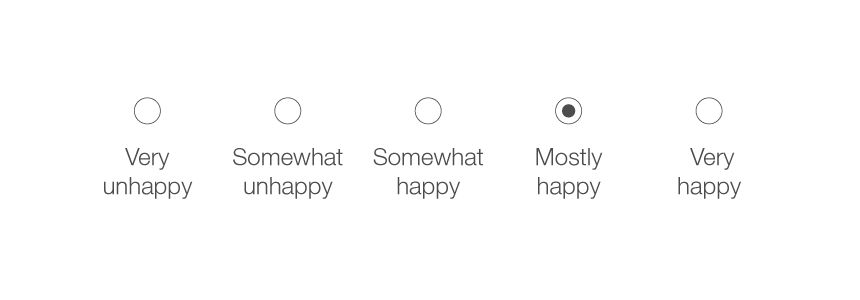The Right Employee Survey Response Scales: How To Best Engage Employees in Your Surveys

There’s a lot to consider before you conduct an employee survey.
If you already know your objectives and have picked your questions, you’re almost there. But deciding how you want employees to respond to your questions and which response scales to use is just as much of a science as deciding what to ask.
That’s why we’re here with some guidance. We’ll give an overview of some of the most commonly used response scales, providing a combination of nerdy insights and practical advice to help you design better employee surveys.
And if you want to jump straight into collecting employee feedback, check out our 10 pre-made employee pulse survey questions.
The Likert scale
If you’ve ever taken a survey, there’s a good chance you’ve come across a Likert scale. Likert scales are usually five-point, seven-point, or ten-point, bipolar scales that capture responses from one extreme to the other. Likert scales help quantify otherwise unquantifiable factors such as emotions and attitudes. For example:
How satisfied are you at work?

Balanced and unbalanced Likert scales
Likert scales can be balanced or unbalanced. Balanced Likert scales have midpoints, which are usually neutral points, as in the example above.
On the other hand, an unbalanced scale skews more towards one end of the scale. For example:
How happy are you in your current job role?

This scale skews more to the positive end of the scale with responses ranging from “somewhat happy” to “mostly happy” to “very happy.”
Balanced scales are more commonly used over unbalanced scales because they offer equal points of variation on either side of the neutral point, which reduces the possibility of bias towards either end of the scale.
However, unbalanced scales are useful when you know that most of your respondents feel a certain way about an issue. By offering an unbalanced response scale, you can offer more points of variation in that particular spectrum (i.e. in the case of the scale above, how a respondent would land on the happiness spectrum).
Visual Likert scales
So far we’ve looked at Likert scales that collect worded responses, but it’s possible to build them using numbers or even visuals, too. For example:
How would you rate your work-life balance?

A scale of faces or emojis is an effective way to collect feedback on questions relating to satisfaction levels and feelings, as the faces can convey emotions or attitudes in a simple, instantly recognizable format.
A rating scale using stars is commonly used to collect feedback on standards and satisfaction. For example:
Rate the training session you attended on improving your organization skills:

The benefit of using visual scales is that they are easily identifiable and can help make the survey-taking experience less tedious and, in some cases, more fun.
However, when using visual scales, you should try to stick to ones that are commonly used. Using visuals that your respondents are unfamiliar with or don’t understand will lead to inaccurate data.
Number scales vs. word scales
For responses that cannot be translated into visuals, scales using numbers or words are the best option. There are advantages and limitations in using each.
Numbers scales are:
+ Easy to analyze.
+ Easily expandable for more precise answers. For instance, expanding a five-point scale to seven or ten points.
– Potentially subjective based on cultural differences. For instance, a seven on a ten-point scale could mean neutral or positive depending on where your respondents come from in the world.
Worded scales are:
+ Descriptive and allow respondents to externalize their feelings and pick a label that best reflects their opinions.
– Potentially overwhelming if the scale is too long or unclear.
Opt-out categories
Regardless of which type of Likert scale you use for your employee survey questions, it’s a best practice to include an opt-out category, such as “Don’t know”, “Prefer not to say” or “Not applicable.”
Of course, there are questions where you will want your respondents to answer explicitly rather than taking the easy option by opting out. But, generally, failing to include an opt-out category increases the risk of survey abandonment and can lead to inaccurate results.
For example, asking your employees to rate your last town hall meeting on a scale of 1 to 5 would obviously not be applicable to those who did not or could not attend.
If you don’t provide a “not applicable” option, respondents may either choose to abandon the survey because they don’t think it’s relevant to them, or choose a random response — known as a false positive.
Dichotomous scales
We’ve looked at survey scales that are typically five-, seven-, or ten-point scales, but they can be as short as two. Two-point scales, or dichotomous scales, are bipolar and can be useful for getting quick feedback or measuring the popularity of a single action. For example:
Did you attend last month’s town hall meeting? Yes / No
Though these scales don’t provide insight into the degree of response, they work well for simple polls. For instance, you may want to gauge employee interest in attending a specific training course. Or you could use this scale to survey whether employees have read and understood a policy change document you sent out by internal email.
As with the Likert scale, you can use visuals to represent a dichotomous scale. For example:
Did you agree with the recent updates we made to the company vacation policy?

Even with only two response options, we recommend including an opt-out category for questions where doing so makes sense.
Open-ended employee survey questions
All of the examples above are quantitative questions where we collect fixed responses on a predetermined scale. Because the responses are standardized, analysis can be based on the quantity of responses for each available option.
If you want deeper insight into the “why” behind a response, you have to give your respondents the chance to more freely voice their opinion. To do that, you need to move past scales and on to open-ended questions.
Here’s an example of how you can use an open-ended question in combination with a quantitative one:
On a scale of 1 to 5, rate how satisfied you are with the training you received for your role.

Why would you say you are [response from previous question, e.g. Somewhat dissatisfied] with the training you received for your role?
Because open-ended questions provide deeper insight, it might be tempting to follow every quantitative question with one. However, you should keep in mind that the responses can be much harder to analyze and time-consuming to process.
Choosing your questions and scales
The objective of your survey, your survey style (annual, pulse, etc.), time constraints, and survey sample size will all play a part in helping you decide which questions and scales to use.
There are many more styles of questions and scales out there but the ones above are some of the most widely used, so they’re a great place to start.
If you find the process of designing an employee survey overwhelming, or you’d like to get an idea of the types of questions other organizations are asking (or should be asking), check out these other great employee survey resources:










